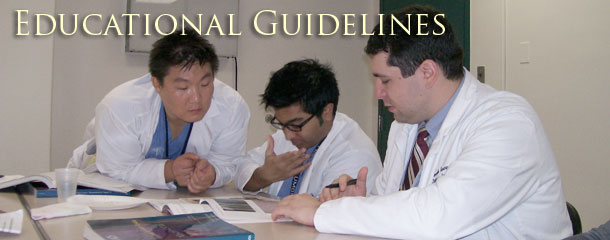Department of Orthopaedics
140 Bergen St.
Suite D-1610
Newark NJ 07103
973-972-2151
Email Contacts:
For Housestaff and Student Inquiries:
Monique A. Smith
Program Support Coordinator
Phone 973-972-3860
Fax 973-972-9367
NJMSOrthoresidency@njms.rutgers.edu
 |
|
|
It appears that the effectiveness of such traditional teaching methods
as lectures and conferences can be greatly enhanced if they are complemented
by a pre-learning phase (i.e.: preparatory reading) and a post-learning
phase (regular reviews of the required material). During the actual teaching
event, the teacher should regularly interact with the residents to ascertain
that they have understood the reading material and can apply it appropriately.
To give the residents enough time for preparation, the core learning programs
and the individual teaching programs of the affiliated hospitals should
be distributed at least three months ahead of time. These programs should
identify those responsible for various teaching efforts and should indicate
what preparatory reading is required. Review quizzes with a clear delineation
of the material covered should be held at one to three month intervals.
SPECIFIC LEARNING AND TEACHING METHODS
Overview
The following methods and materials will be employed in the learning
process:
- List
of core textbooks, course scientific articles and core audiovisual or
electronic learning aids instruction in optimal learning and test taking
methods
- Facilitation
of computer literacy
- A
core educational program that reviews all the material pertinent to
good orthopaedic practice in a two year cycle
- Lectures
and teaching sessions by outside guest speakers
- Varied
orthopaedic teaching programs at each of the affiliated hospitals with
focus on the hospital's strengths
Instructional
Materials
The preparatory reading indicated and the teaching schedule
should be related to core textbooks, scientific articles, the Orthopaedic
Knowledge Update(OKU) or the audiovisual material available in the orthopaedic
learning center. Per hour taught, the reading of not more than four to
six articles should be required. Seven copies of all material that
is not part of the core textbooks or the OKU must be handed in to the
Orthopaedic Residency Coordinator three weeks before the teaching event
so that it can be made available to the residents ten days to two weeks
beforehand. For each learning event, the responsible teacher will
prepare three multiple choice questions, which are available from the
Orthopaedic Residency Coordinator, that will form the basis of a review
quiz to be administered every two months.
Learning Events
The principal learning events include the following:
|
Grand Rounds lectures:
These lectures should be of interest to the orthopaedic community and
should carry CME accreditation.
Faculty lectures:
These lectures should be didactic in nature and review specific topics
in comprehensive fashion. They should be based on current textbook
knowledge and incorporate discussion of the 4-6 principal publications
concerning the topic. During the lecture, particularly when these publications
are discussed, the resident should be involved interactively.
Resident
lectures:
Each resident is expected to give approximately one lecture a year.
These should be formal presentations that include slides, handouts,
and reference lists.
Tutorials or "Closed Book" interactive sessions between faculty and
residents:
These are based on key learning material that the residents have mastered.
The following will be taught in the form of tutorials: 1) the Orthopaedic
Knowledge Update (two-year cycle), and 2) topic tutorials. The
tutor keeps a list that reflects the resident's performance. This
record is handed in to the Orthopaedic Residency Coordinator at the
end of the session.
Multidisciplinary conferences:
These are devoted to case presentations that involve specialties other
than orthopaedic surgery and are organized by one or more faculty members.
Quizzes:
Each teacher responsible for a learning session prepares three multiple
choice questions for each hour taught that reflect on the topic covered
and is based on material that has been handed to the residents. Every
two months a number of these multiple choice questions are chosen to
test effectiveness of the learning process.
Anatomy:
Anatomy will be covered by each hospital. The resident will receive
a proposed curriculum, complimented by cadaveric dissections and clinical
correlation. The Department also funds an e-Anatomy online subscription which is an interactive human anatomy atlas, developed on the IMAIOS website. It is designed for use by doctors, radiologists, students, and medical imaging specialists. The application presents medical imaging examinations (CT scan, MRI, radiographs) with annotated anatomical structures and diagrams.
|
